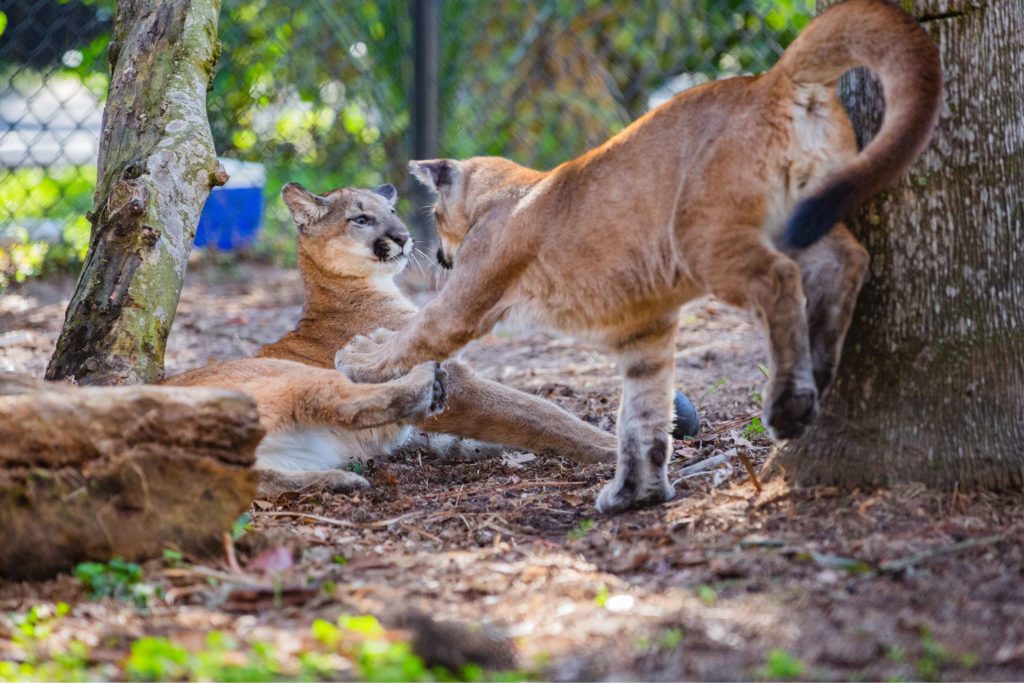White Oak Conservation
Press Release
January 16, 2020
Northeast Florida Wildlife Refuge Will Be Kittens’ Permanent Home
White Oak Conservation has adopted two endangered Florida panther kittens after a mysterious neurological disorder left their mother unable to care for them.

The Florida Fish and Wildlife Conservation Commission (FWC) observed the radio-collared mother on trail camera footage in July as she struggled to walk, hobbled by rear leg weakness.
In early July, state wildlife officials took in her two male kittens, then estimated to be two weeks old, because they would not have survived on their own, and brought them to Animal Specialty Hospital for care. Following almost two months of nursing care, the kittens were then transferred to ZooTampa at Lowry Park for evaluation and care.
The kittens, named Cypress and Pepper, are expected to be transferred to White Oak from ZooTampa next week. (Photos are available here. Mandatory credit: Rachel Ross, ZooTampa.)
Both kittens have undergone several health screenings and been given the all-clear. They are about seven months old and will continue to be monitored for signs of the disorder.
“These young kittens will live out their lives at White Oak in peace and safety,” said Mark Walter, White Oak’s owner, who leads Walter Conservation with his wife, Kimbra. “These recent health challenges with the panthers in South Florida are poignant reminders that White Oak and our partners must be vigilant and quick to respond if we are to save animals from emerging threats.”
Other panthers and bobcats have demonstrated similar rear leg weakness, and FWC is monitoring the issue and exploring possible causes, such as exposure to toxins, infectious disease or a nutritional deficiency. The mother in this case had to be captured and euthanized after her health deteriorated.
There are only about 200 left in the wild today; most are isolated in southern and central Florida. Indiscriminate killing in past centuries and, more recently, habitat loss and collisions with cars have resulted in panthers being one of Florida’s most endangered species.
Since 1986, White Oak has partnered with Florida wildlife officials to rehabilitate and release 19 sick or injured Florida panthers, many of which were struck by cars, under the direction of senior veterinarian Scott Citino. This includes the first panther family rehabilitated and released into the wild together in 2018.
The species was headed toward extinction until the Endangered Species Preservation Act. The Florida panther was among the first to gain protection under the landmark 1966 federal law.
But more is needed as Florida continues to lose hundreds of thousands of acres of rural land to provide for new homes and new residents. More concerning are the new roads being built across panther home ranges, often after the areas are sold to housing developers.
“We need more private and public lands preserved, and we need dedicated wildlife crossings that enable the panther population to move, expand and thrive,” Walter said. “Otherwise, our generation will be responsible for the extinction of the Florida panther.”
Walter Conservation works to save endangered species and preserve large, wild spaces across the globe. Habitat preservation is just as, if not more, critical to species survival; sufficient loss is proven to lead to extinction. This is why the Walters preserve large areas of open lands from North America to Africa, protecting them from further development and managing them in ways that speed species recovery.
Facts about Florida panthers:
Florida panthers are at the top of the food chain, with no natural predators. They eat only meat.
The biggest cause of mortality is collision with vehicles.
Panthers are elusive and solitary, coming together only for mating.
The females raise their kittens on their own.
Gestation is 90-95 days.
Kittens are weaned at six months.
They may stay with their mother for up to 20 months; siblings may stay together for a few months thereafter.
Male home ranges cover up to 200 square miles.
Males are intolerant of other males who enter their home ranges.
As once-wild home ranges get carved up for development, panthers are brought into greater contact with each other and with humans, putting them at greater risk. This is why habitat preservation is so critical to species survival.
About White Oak Conservation
White Oak is part of Walter Conservation, led by Kimbra and Mark Walter, which works to save endangered species and preserve wild places in many countries. White Oak pioneers global conservation efforts through innovative science; breeding; species reintroduction; education programs; and collaborations with other conservation groups and governments. White Oak’s 17,000 riverfront acres in northeast Florida provide a refuge for more than 17 endangered species.
